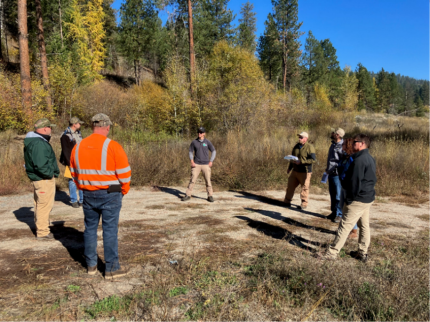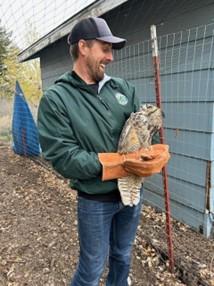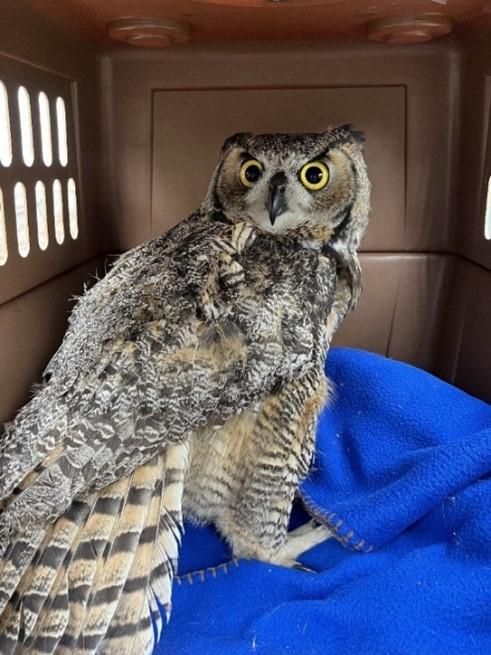Managing Wildlife Populations
Carcass Pit Inspection: Sherman Creek Wildlife Area Assistant Manager Palmer and Wildlife Area Manager Anderson hosted a tour of the state Department of Transportation’s (DOT) Trout Lake roadkill carcass pit, located off state Highway 20, at Sherman Creek Wildlife Area. Two DOT employees and seven Washington State Department of Fish and Wildlife (WDFW) Region 1 employees attended. They were trying to determine what can be done to keep large carnivores from scavenging out of the pit, which is a somewhat shallow, narrow, and short trench. They will be pursuing the most promising option, working to arrange a drop-off agreement with the county landfill.
Washington department of Fish and Wildlife (WDFW) staff members also inspected the WDFW farm animal compost facility located nearby, which is also on WDFW land. This fenced facility provides an option for local farmers to have WDFW conflict staff members dispose of dead livestock. This facility is not meant for wildlife, because compost from wild ungulates can have limited use due to disease concerns.

Chronic Wasting Disease: Private Lands Biologist Nizer led a chronic wasting disease (CWD) check station at Washtucna. Nizer had one volunteer from Washington State University that he taught to take lymph nodes out. Nizer also checked hunting camps and took five samples at a camp.

Private Lands Biologist Nizer transferred CWD samples to Chronic Wasting Disease Surveillance Coordinator Westacott from the 21st and 22nd check stations.
Natural Resource Technician Heitstuman staffed the Evan’s Road Check Station near Asotin with Natural Resource Technician Tritt. Closing weekend did not provide many sampling opportunities. Samples were transferred as requested. They also checked on Department of Transportation roadkill collections.
Selkirk and Cabinet-Yaak Grizzly Bear Conservation Strategy: Wildlife Biologist Prince participated as a technical team member at the first grizzly bear conservation strategy meeting. The conservation strategy, once developed, will serve as the management document for the Selkirk and Cabinet-Yaak grizzly bear populations. The first meeting focused on demographic monitoring and habitat management. The strategy will likely take many years to draft before it will be available for public comment.
Providing Recreation Opportunities
Hunter Check Stations: Biologist Brinkman ran the hunter check station along Highway 395 north of Deer Park, with assistance from Chronic Wasting Disease Biologist Westacott. This check station provides an opportunity for biologists to interact with hunters participating in the modern firearm deer season. Biologists collected samples from hunter-harvested deer as part of a CWD surveillance effort in Region 1. One hunter had also harvested a grouse and left the wing and tail with the biologists to be submitted with wing barrel samples.
Rock Lake Access Site: The Yakima and Lacey construction shops teamed up for a toilet removal at Rock Lake. Region 1 Access Manager Dziekan went out to the access area ahead of time to salvage parts from the fiberglass toilets before they were demolished. Dziekan helped tear out the fencing around the outhouses so that the parts could be used at other sites.
The construction crew removed the fence posts that were concreted in the ground, tore the fiberglass toilets down, had the vaults pumped, then tore the concrete holding tanks out of the ground. The construction crew finished the project with dirt and gravel in the holes and smoothed out the area. Once the construction crew was finished it was hard to tell anything was ever there. Dziekan scheduled the delivery of portable toilet units to be used until a more permanent agreement can be worked out with the property owners.
Private Lands Access: Private Lands Biologist Nizer has been working with an avid hunter since June about where he should take his grandson hunting in Whitman County. Nizer coordinated with landowners and provided access through the landowner's access list that allows hunters to access private lands. Nizer received a picture of a harvested mule deer on one of the access sites by the successful grandson.

Asotin Creek Wildlife Area Elk Hunting: Elk hunters were setting up camps and preparing the Friday before opening day at Smoothing Iron Ridge. Very few elk had been observed on the wildlife area as of that Friday. It is difficult to determine the reasons why elk observation is low.

Rustlers Gulch Trail Clearing: Sherman Creek Wildlife Area Assistant Manager Palmer spent the week using his mini-excavator at Rustlers Gulch Wildlife Area to clear brush on an extensive system of trails between Beaver Creek and Horseshoe Lake. These trails are very popular with horseback riders.


Providing Conflict Prevention and Education
Beaver, Farmington: Wildlife Conflict Specialist McCarty connected with Habitat Biologist Mackelvie on a beaver dam that was causing flooding in Farmington. Mackelvie and McCarty established a plan to visually evaluate the dam and once they speak to the landowner to decide if pond levelers or hydraulic project approval would be most effective.
Beaver Relocation Site Survey: Wildlife Conflict Specialist Kolb met with a permitted beaver relocator and a landowner in Walla Walla County to access and score potential beaver relocation sites. The landowner is enthusiastic about the possibility of beaver being relocated to their property. Additional coordination and follow-up with District 3 staff members will be necessary before any relocation effort is initiated.
Bear Depredation: Acting Wildlife Conflict Specialist Harris responded to a report of a black bear killing and dragging off a domestic sheep. Harris and Officer Beauchene investigated and determined that a black bear was responsible for killing two sheep over the past week. A culvert trap was set in response to the depredations. Wildlife Conflict Specialists Harris and Samsill called out hound hunters to track down the bear, resulting in the bear being removed. They collected tooth samples, and the bear meat was donated.
Great Horned Owl: Biologist Brinkman and Conflict Specialist McCarty responded to a call of a great horned owl entangled in netting material that was stretched over the top of a chicken coop/run. The owl was presumably attempting to prey upon one of the chickens and got tangled in the mesh netting in the process. The mesh was wrapped tightly around one foot, cutting off circulation to the toes and causing minor abrasions as the owl fought to get free. Brinkman and McCarty were able to restrain the owl and remove the netting from the injured foot. It was determined that the owl should go to a wildlife rehabilitation facility for further evaluation and monitoring but seems likely that it will make a full recovery and be released back into the wild.


Northport Bear Smart Discussion and Planning: Wildlife Conflict Specialist Bennett began work on Northport becoming a bear smart community with bear proof garbage receptacles and assisting landowners with securing attractants.
Depredation Investigation: WDFW staff members investigated an injured adult cow in Grouse Flats territory. The determination of the investigation was a confirmed wolf depredation.
Conserving Natural Landscapes
Revere Habitat Restoration: Wildlife Area Assistant Manager Rimmelspacher and Private Lands Biologist Baarstad went to the Revere Wildlife Area with an ATV and broadcast spreader to seed after the disturbance from the Wagner fire and pole replacement. The Avista Company hired a contractor to repair the damage below the newly installed power poles and Rimmelspacher broadcast seeded a native grass mix. Rimmelspacher also broadcast seeded a pollinator mix forb mix in a food plot area that the Pheasant Forever Chapter had used for several years.


Duck Stamp Project: Private Lands Biologist Nizer and Natural Resource Technician Rumiser mowed a marsh wetland area with a marsh master to provide water access for waterfowl and hunters on a private lands hunting access site in Whitman County. The site will take about a week to mow all 12 acres of bull rush and cattails.



Habitat Project: Private Lands Biologist Hadley planted several shrubs at a habitat project and spot sprayed for weed control at another location. Coordination plans were made for upcoming habitat field day with the Walla Walla Conservation District and Pheasants Forever in coming together to plant shrubs on a landowner’s property in Walla Walla County.
W. T. Wooten Wildlife Area Noxious Weed Control: Natural Resource Technician Jensen sprayed weeds at the Hartsock Unit, Russell Unit, and in the fields at the headquarters. Natural Resource Technicians Jensen and Tritt traveled to Walla Walla County with the dump trailer and cleaned up kochia and Russian thistle that is growing around the Stovall Road parking area. Wildlife Area Manager Dingman began working on the annual Rocky Mountain Elk Foundation grant application to get funds to aerially spray yellow star thistle infestations on the W. T. Wooten Wildlife Area.
Native Seed Planting: Acting Private Lands Biologist Nizer seeded an 8-acre plot of land in Albion. The landowner just joined the hunt by written permission program for a total of 100 acres with habitat for deer, pheasant, and waterfowl. The native seed planting will provide cover for pheasant and food for deer during the hunting seasons.

Marsh Master: Private Lands Biologist Nizer finished mowing about 20 acres of bull rush in a wetland. The bull rush wasn’t allowing ducks to land in waterways because of overgrowth and didn’t allow for hunters to find good access to water. This mowing will be followed by either a prescribed burn or chemical spraying to reduce regrowth in the spring.


Habitat Project: Private Lands Biologist Hadley presented an outdoor workday partnering with Walla Walla Conservation District and Pheasants Forever. They came together to plant shrubs and seed a pollinator friendly grass seed mix on a landowner’s property outside of Dixie. The outdoor education program is from a grant that the Walla Walla Conservation District wrote that involves a service-learning program for K-12th grade focusing on restoration and salmonid habitat.
Providing Education and Outreach
Williams Lake Eagle Scout Project: Region 1 Access Manager Dziekan was contacted by Life Scout Colin Martinez. Colin is interested in an eagle scout project on our state lands. Martinez would like to install a life jacket loaner station at Williams Lake, a lake that he and his family frequent.
Dziekan met on site with Life Scout Martinez’s mother, laid out some plans, and started the process on his project. Dziekan shared some information on another life jacket loaner station that was installed as an eagle scout project at Liberty Lake.
Life Scout Martinez plans to spend the winter working on securing funds for the loaner station, building it, and then will install it next spring. If the weather holds out, he will install it this winter, but there is also no rush on his project as he still has several years left in scouting.
Conducting Business Operations and Policy
Region 1 Access Tour: Lowery, Gibbons, Robinette, and Dziekan toured Newman Lake, Liberty Lake, West Medical Lake, and Clear Lake to inspect the Gray fire damage and other management issues relating to the access sites.
At Clear Lake, Dziekan pointed out the surrounding ramps that were installed over 50 years ago and the issues with them. It was good to show Lowery and Gibbons the issues that access staff members are having to deal with every day. Just recently, Dziekan has had to clean up graffiti painted on the outside of the bathrooms at both Reardan Audubon and Newman Lake.

Reardan Audubon Wildlife Area Tour: This week’s tour also included the Reardan Wildlife Area. Lowery, Gibbons, Robinette, Dziekan, Wildlife Area Manager Finch, and Wildlife Area Assistant Manager Rimmelspacher went over the management and the type of work staff members do to maintain the unit. Wildlife area staff members will be calculating how much time is spent over the biennium maintaining the unit, which includes herbicide treatment, litter activities, and general parking lot maintenance.